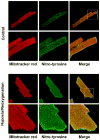Peroxynitrite-mediated oxidative modifications of complex II: relevance in myocardial infarction
- PMID: 20143804
- PMCID: PMC3754874
- DOI: 10.1021/bi9018237
Peroxynitrite-mediated oxidative modifications of complex II: relevance in myocardial infarction
Abstract
Increased O(2)(*-) and NO production is a key mechanism of mitochondrial dysfunction in myocardial ischemia/reperfusion injury. In complex II, oxidative impairment and enhanced tyrosine nitration of the 70 kDa FAD-binding protein occur in the post-ischemic myocardium and are thought to be mediated by peroxynitrite (OONO(-)) in vivo [Chen, Y.-R., et al. (2008) J. Biol. Chem. 283, 27991-28003]. To gain deeper insights into the redox protein thiols involved in OONO(-)-mediated oxidative post-translational modifications relevant in myocardial infarction, we subjected isolated myocardial complex II to in vitro protein nitration with OONO(-). This resulted in site-specific nitration at the 70 kDa polypeptide and impairment of complex II-derived electron transfer activity. Under reducing conditions, the gel band of the 70 kDa polypeptide was subjected to in-gel trypsin/chymotrypsin digestion and then LC-MS/MS analysis. Nitration of Y(56) and Y(142) was previously reported. Further analysis revealed that C(267), C(476), and C(537) are involved in OONO(-)-mediated S-sulfonation. To identify the disulfide formation mediated by OONO(-), nitrated complex II was alkylated with iodoacetamide. In-gel proteolytic digestion and LC-MS/MS analysis were conducted under nonreducing conditions. The MS/MS data were examined with MassMatrix, indicating that three cysteine pairs, C(306)-C(312), C(439)-C(444), and C(288)-C(575), were involved in OONO(-)-mediated disulfide formation. Immuno-spin trapping with an anti-DMPO antibody and subsequent MS was used to define oxidative modification with protein radical formation. An OONO(-)-dependent DMPO adduct was detected, and further LC-MS/MS analysis indicated C(288) and C(655) were involved in DMPO binding. These results offered a complete profile of OONO(-)-mediated oxidative modifications that may be relevant in the disease model of myocardial infarction.
Figures









Similar articles
-
Oxidative modifications of mitochondria complex II.Methods Mol Biol. 2013;1005:143-56. doi: 10.1007/978-1-62703-386-2_12. Methods Mol Biol. 2013. PMID: 23606255 Free PMC article.
-
Protein tyrosine nitration of the flavin subunit is associated with oxidative modification of mitochondrial complex II in the post-ischemic myocardium.J Biol Chem. 2008 Oct 10;283(41):27991-28003. doi: 10.1074/jbc.M802691200. Epub 2008 Aug 5. J Biol Chem. 2008. PMID: 18682392 Free PMC article.
-
Protein thiyl radical mediates S-glutathionylation of complex I.Free Radic Biol Med. 2012 Aug 15;53(4):962-73. doi: 10.1016/j.freeradbiomed.2012.05.025. Epub 2012 May 24. Free Radic Biol Med. 2012. PMID: 22634394 Free PMC article.
-
Prokaryotic assembly factors for the attachment of flavin to complex II.Biochim Biophys Acta. 2013 May;1827(5):637-47. doi: 10.1016/j.bbabio.2012.09.003. Epub 2012 Sep 14. Biochim Biophys Acta. 2013. PMID: 22985599 Review.
-
Kinetics of peroxiredoxins and their role in the decomposition of peroxynitrite.Subcell Biochem. 2007;44:83-113. doi: 10.1007/978-1-4020-6051-9_5. Subcell Biochem. 2007. PMID: 18084891 Review.
Cited by
-
Reperfusion mediates heme impairment with increased protein cysteine sulfonation of mitochondrial complex III in the post-ischemic heart.J Mol Cell Cardiol. 2021 Dec;161:23-38. doi: 10.1016/j.yjmcc.2021.07.008. Epub 2021 Jul 29. J Mol Cell Cardiol. 2021. PMID: 34331972 Free PMC article.
-
Redox regulation of mitochondrial function with emphasis on cysteine oxidation reactions.Redox Biol. 2013 Dec 19;2:123-39. doi: 10.1016/j.redox.2013.12.011. eCollection 2014. Redox Biol. 2013. PMID: 24455476 Free PMC article. Review.
-
Impaired Myocardial Mitochondrial Function in an Experimental Model of Anaphylactic Shock.Biology (Basel). 2022 May 10;11(5):730. doi: 10.3390/biology11050730. Biology (Basel). 2022. PMID: 35625458 Free PMC article.
-
Mitochondrial VDAC1: A Key Gatekeeper as Potential Therapeutic Target.Front Physiol. 2017 Jun 30;8:460. doi: 10.3389/fphys.2017.00460. eCollection 2017. Front Physiol. 2017. PMID: 28713289 Free PMC article. Review.
-
Factors influencing protein tyrosine nitration--structure-based predictive models.Free Radic Biol Med. 2011 Mar 15;50(6):749-62. doi: 10.1016/j.freeradbiomed.2010.12.016. Epub 2010 Dec 21. Free Radic Biol Med. 2011. PMID: 21172423 Free PMC article.
References
-
- Lemos RS, Fernandes AS, Pereira MM, Gomes CM, Teixeira M. Quinol:fumarate oxidoreductases and succinate:quinone oxidoreductases: phylogenetic relationships, metal centres and membrane attachment. Biochim Biophys Acta. 2002;1553:158–170. - PubMed
-
- Chen YR, Chen CL, Pfeiffer DR, Zweier JL. Mitochondrial Complex II in the Post-ischemic Heart: OXIDATIVE INJURY AND THE ROLE OF PROTEIN S-GLUTATHIONYLATION. J Biol Chem. 2007;282:32640–32654. - PubMed
-
- Zhao X, Chen YR, He G, Zhang A, Druhan LJ, Strauch AR, Zweier JL. Endothelial nitric oxide synthase (NOS3) knockout decreases NOS2 induction, limiting hyperoxygenation and conferring protection in the postischemic heart. Am J Physiol Heart Circ Physiol. 2007;292:H1541–1550. - PubMed
Publication types
MeSH terms
Substances
Grants and funding
LinkOut - more resources
Full Text Sources
Medical

